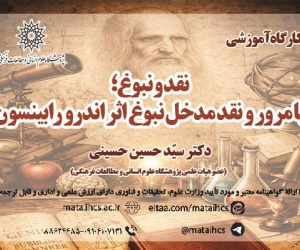دانش بومی شترداری در قلمرو عشایر ایل کلکویی (مقاله علمی وزارت علوم)
درجه علمی: نشریه علمی (وزارت علوم)
آرشیو
چکیده
دانش بومی ﺷﺘﺮداری در مناطق بیابانی ﯾﮑﯽ از آن ﻣﻘﻮله هایی اﺳﺖ ﮐﻪ ﺑﺎوﺟﻮد ﻗﺪﻣﺖ و اﻧﺤﺼﺎرﺗﻘﺮﯾﺒﯽ آن در ﻣﻨﺎﻃﻘﯽ ﭼﻮن اﯾﺮان ﭼﻨﺪان ﮐﻪ باید ﺷﺎﯾ ﺴﺘﻪ ﺗﻮﺟﻪ ﺑﺎﺷﺪ ﻣﻮردبررسی قرارنگرفته است. هدف این تحقیق شناسایی دانش بومی شترداری در قلمرو عشایر ایل کلکویی در دشت مسیله استان قم بوده که دارای سابقه دیرینه شترداری در این منطقه می باشند. شیوه دستیابی به داده ها به ﺻﻮرت ﻣﯿﺪاﻧﯽ با حضور مستمر بین عشایر ایل کلکویی به شیوه مصاحبه(پرسش و پاسخ)، مشاهده، فیلمبرداری و عکسبرداری طی سه سال صورت گرفته است همچنین علاوه بر مصاحبه های انفرادی با شترداران بومی و خبرگان عشایر به منظور گردآوری داده ها و آگاهی به دانش بومی شترداران از مصاحبه های گروهی نیز استفاده به عمل آمده است . اطلاعات براساس همگرایی و واگرایی طبقه بندی شده است یافته ها شامل دانش بومی مربوط به نامگذاری ، نشانه گذاری، جایگاه شتر، ویژگی شتر خوب و تولید مثل بین عشایر ایل کلکویی بوده است. نتایج تحقیق در قلمرو عشایر ایل کلکوئی نشان داد ایشان در امر شترداری از دانش بومی و تجربه شغلی گسترده ای برخوردارند .The indigenous knowledge of camel husbandry in Kalkooyi nomads territory
The aim of this research is to identify the indigenous knowledge of camel husbandry in the territory of Kalkuyee nomads in Masileh plain of Qom province, who have a long history of camel husbandry in this region. The way of obtaining the data is in the field with the continuous presence of the tribes of the Kalkuyee tribe in the form of interview (question and answer), observation, filming and photography during three years. Also, in addition to individual interviews with native camel herders and nomadic experts, group interviews were also used in order to collect data and gain knowledge about the local knowledge of camel herders. The information has been classified based on convergence and divergence. The findings include indigenous knowledge related to naming, marking, the position of camels, characteristics of good camels, and reproduction among nomads of Kalkuyee tribe. The results of the research in the territory of Kalkuyee nomads showed that they have local knowledge and extensive work experience in camel husbandry. From the local knowledge of camel herders, we come to the conclusion that camel herding has long been a traditional and cultural activity with specific regional characteristics, and with camel herding and traditional life,









